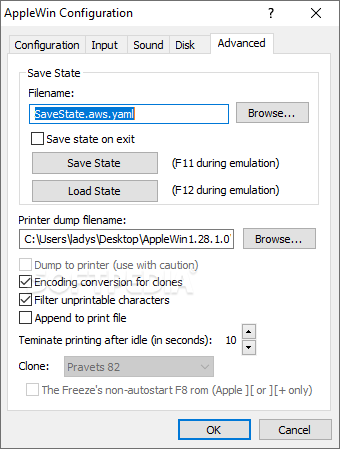

A simple bleep can be made using PRINT CHR$(7) in BASIC but to do anything else with the built-in speaker you must use PEEK, passing certain values, which may seem odd as PEEK is normally used for returning a value from memory but certain addresses cause an action to occur, such as for the speaker to toggle on/off.įor more information about creating sound on the Apple II computers please see: Sound on the IIe, as with the other II models, is very limited, only capable of 1 bit tones, by rapidly switching the speaker on/off at a particular frequency and by not having a dedicated sound chip, sound generation tied up the CPU and limited what sounds could be produced. You can see the screenshots taken using the HDMI converter along with my Elgato capture card on this page.

In graphics mode the images are not too bad (some colour bleeding) and o n the downside of using the adapter it forces the i mage to be stretched so any captures I do I then have to correct in an image/video editing program to be the correct aspect ratio. In my striving to improve the composite output of the II e I tried two SCART composite to HDMI converters and found the cheaper one did an amazing job in produ cing crisp, clear composite images when the IIe is in text mode, to the point it looked like RGB rather than composite because of how clear the video looked. There are RGB plug-in cards and 80 column cards with their own composite or other type of video connector available but if you don't have access to one an option is to use a composite to HDMI con verter. Most modern monitors and TVs will have a difficult time interpreting the video signal, resulting in poor quality images.
APPLEWIN MAKE SECONDARY JOYSTICK PRIMARY TV
Trying to use a IIe, enhanced version or not, on a modern TV or monitor will likely look very bad as the machines had very poor composite signal for both NTSC and PAL machines, a video signal that was non-standard at the time, but worked with the monitors available when the computers were on sale. No support for coloured text was added, and this is the case for all Apple II computers. The IIe, as with other II models, has no numpad as standard but it is possible to add one to connector J16 on the motherboard, located next to the main keyboard connector J17, and the IIe Platinum does feature a keyboard with a numpad.Ī downside with the IIe trying to maintain backward compatibility with the II is that text is monochrome only text is normally white on black, or black on white using the INVERSE BASIC command.
APPLEWIN MAKE SECONDARY JOYSTICK PRIMARY SOFTWARE
The caps lock is of the latching type and is required to be down (caps lock on) for compatibility with software designed for Apple computers that only supported upper case. There are 62 keys that make up the keyboard (63 including the reset button) and each key has automatic repeat (hold down a key for to activate) and the keyboard also has N-key rollover, that is, you can hold down any combination of keys and each one is detected individually. Additionally, a n Enhanced IIe identifies itself with 'Apple //e' on its start up screen as opposed to 'Apple ][' for the standard IIe. From the outside the Enhanced IIe is distinctive because it has either an Enhanced sticker or a 65C02 sticker on the power indicator, between the caps lock and the open-Apple key. Although some software required the Enhanced IIe, there were some compatibility issues with older programs. T he Enhanced IIe has a 65C02 CPU (additional instructions and ran cooler compared to the standard 6502 ), a new character ROM (includes MouseText characters) and 2 new firmware chips (bug fixes, lowercase support in Applesoft BASIC and the Monitor). The Apple Enhanced IIe is an enhanced version of the Apple IIe - which is an enhanced version of the Apple II - so in a sense it's doubly enhanced, and was released in March 1985, 2 years after the IIe.

While this section concerns the Enhanced IIe, much of it will also be appl icable to the standard IIe. A spect ratio has been corrected but in the conversion to HD there will be large borders. Please note that unless otherwise stated all screenshots on this page were taken from an Enhanced IIe via its composite connection, converted to HDMI and then captured using an Elgato capture card.


 0 kommentar(er)
0 kommentar(er)
